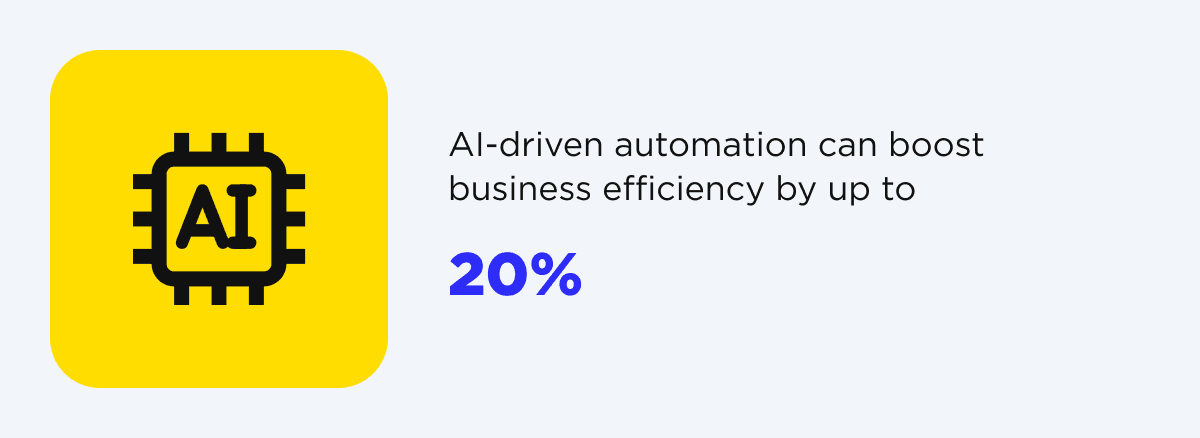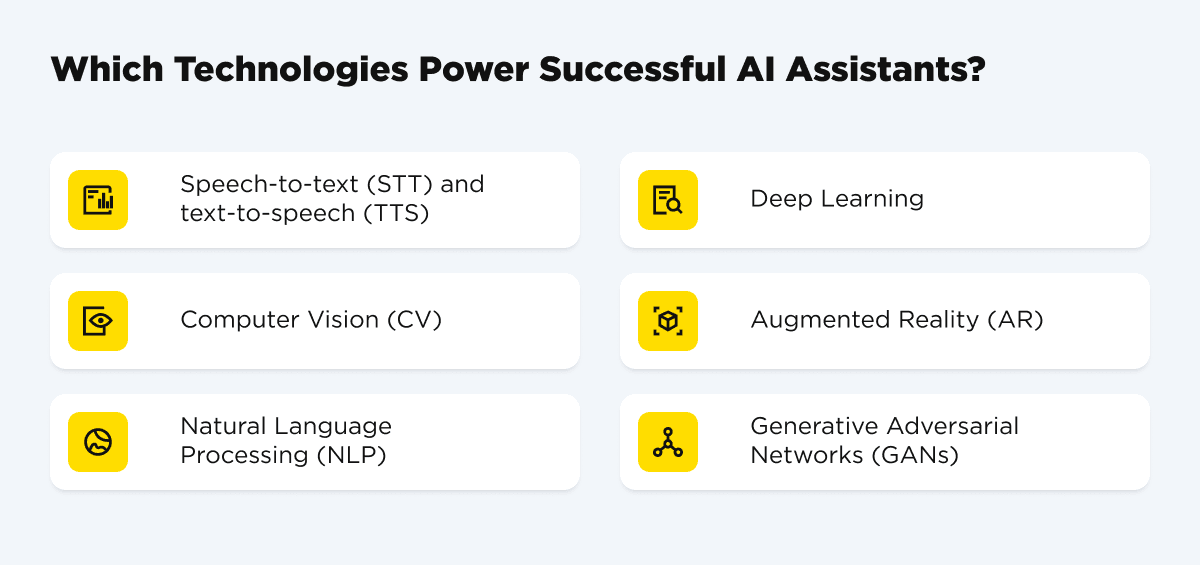Can you imagine a world where every mundane task is handled seamlessly, your schedule is efficiently aligned, and customer queries are answered before you’ve even had your morning coffee? Probably, it would have sounded unrealistic, like about 10 years. However, nowadays, we can welcome you to the era of AI virtual assistants. The word assistant can give you some tips, of course. Nevertheless, virtual ones represent a real transformative force that’s changing how we work and redefining what’s possible to implement in your business processes. Well, AIs are not just replacing people and stealing jobs, as some might assume. They are really optimizing our workflows.
You can easily consider these digital assistants and multitaskers as your tireless colleagues, always on duty, learning your preferences, anticipating your needs, and streamlining workflows. They are perfectly suited for answering questions like “How can I help you?” and even for delivering some proactive solutions. With their help, you can reach new heights in terms of productivity and customer satisfaction. Moreover, a recent report by McKinsey has highlighted that AI-driven automation has the potential to improve business efficiency by a significant margin of up to 20%.

Would you like to have the same benefits? Absolutely! However, these intelligent helpers can bring some value only when you partner with an experienced AI development company, which will help you tailor the best solution for your business. So, let’s discover AI types, the tech behind them, and the value they bring. Ready to see what the future holds for you? Let’s get started!
Virtual Assistant Software: Defining the Concept
AI virtual assistant software has appeared as a result of advanced developments in smart technologies. As we have already mentioned, you can regard them as your ultimate productivity companions. They combine cutting-edge AI technologies to optimize daily tasks and improve workflows.
Technically speaking, in order to create an AI virtual assistant, engineers integrate multiple technologies like Natural Language Processing (NLP) for understanding and generating human-like text, Machine Learning (ML) for adapting to user preferences, APIs for connecting with external services, and programming languages for more advanced features. There are different frameworks that developers use to build the assistant’s core logic, like TensorFlow or PyTorch. The next step is to train it with relevant datasets and deploy it on cloud platforms. As a result, clients receive responsive and AI-powered smart assistants capable of dealing with diverse tasks efficiently.
We’ve tried to explain the whole concept in general for you to understand how important it is to choose the right development team. Fortunately, successful cooperation can lead to you having solutions that can manage schedules, handle customer queries, check progress, and the like. Their main task is to assist businesses with different workflows.
Ready to explore more? Let’s find out the essential types of AI assistants and the main technologies behind them.

Upgrade your business with tailored AI solutions.
Contact usWhat Are the Key Types of AI Assistants?
As we’ve mentioned above, there are different types of artificial intelligence assistants. They serve various purposes and are tailored to specific needs and environments. Let’s explore the main types and their examples.
Chatbots
Chatbots are the most common type of AI-powered virtual assistant. We are sure you’ve heard of them and even used them multiple times in your lives. They are designed for real-time conversations via text. Mostly, they are great for customer support, answering FAQs, or even processing orders. These tools ensure you have 24/7 online helpers, and they are usually available on websites, messaging apps, and social media platforms. The most common examples of such chatbots are automated chatbots on a bank’s website, What’s App’s chatbots (you can use other messengers), online chatbots on an e-commerce website, and the like.
Voice Assistants
This is another popular type of AI-powered assistant – voice assistant. What kind of cell phone do you use? Have you ever used Alexa, Siri, or Google Assistant? These are the most popular examples of AI voice helpers (quite exciting to have a real talk with a robot, right?). They add a layer of convenience to everyday life. Users can make different voice commands, and these assistants can play music, set reminders, or control smart devices. Users can do a lot without even lifting a finger. It is essential to note here that according to Insider Intelligence data, over 50% of US internet users will use a voice assistant by 2026.

AI Avatars
This type of virtual assistant has brought a new touch to digital experiences. These AI avatars combine virtual personalities and advanced interaction capabilities. You might consider them as more humanized chatbot assistants. Mostly, they’re used in gaming, virtual reality, or as customer-facing representatives (it is especially common in e-commerce, and we bet you’ve encountered them more than once). These avatars bring a human-like touch to user experiences online.
Specialized Virtual Assistants
This AI-based virtual assistant software is tailored to specific industries. Such specialized virtual assistants, thanks to their machine learning capability, can handle niche tasks like medical diagnostics, legal research, or financial planning. Even when you represent more complex industries, you can be sure there are advanced solutions for you as well. In general, they’re customized to solve industry-specific problems and streamline workflows.
What Technologies Stand Behind Successful AI Assistants?
Behind the user-friendly interface of AI assistants lies a complex and intricate web development involving advanced AI technologies. We would like to emphasize that it is always better to consult with professional developers to figure out which technology stack will work best for your project. Anyway, we are here to introduce you to the most popular and widely used technologies that make your personal AI virtual assistant software development a successful venture.

Speech-to-text (STT) and text-to-speech (TTS)
STT converts spoken words into text, enabling voice recognition, while TTS translates written text into spoken language, providing seamless audio output that feels like human speech. For you to understand the usage, these technologies are crucial for voice assistants and accessibility tools.
Popular examples: Google Assistant, Amazon Polly.
Computer Vision (CV)
Computer vision enables AI assistants to "see" by analyzing and interpreting visual data, primarily based on user input. Such applications range from facial recognition to object detection. They particularly enhance interaction in industries like healthcare, retail, and security.
Popular examples: Alexa Show Mode, Google Lens.
Natural Language Processing (NLP)
NLP allows AI to have natural language understanding, interpret, and respond to human language. They carry out operations ranging from sentiment analysis to language translation. In general, NLP ensures meaningful and context-aware interactions between users and machines.
Popular examples: ChatGPT, Microsoft Azure Bot Service.
Deep Learning
Deep learning (as a part of machine learning) powers AI assistants with the ability to learn and improve from data. This tech helps them recognize patterns, predict user needs, and provide smarter and more accurate responses over time.
Popular examples: Siri, OpenAI Codex.
Augmented Reality (AR)
AR combines the digital and physical worlds, enabling AI assistants to interact with their surroundings in innovative and realistic ways. If we are asked to put it simply, imagine an assistant that guides you through home repairs or visualizes furniture placement in your living room. But it is not actually in your living room. Amazing, right?
Popular examples: IKEA Place App, Google ARCore.
Generative Adversarial Networks (GANs)
Trust us, GANs take creativity to the next level. They do so by generating realistic images, videos, or even human-like avatars. This technology powers AI assistants with enhanced customization and creative outputs.
Popular examples: Replika AI, DeepArt.io.
AI-Powered Smart Personal Assistants: Benefits They Bring
While you were learning more about the types of AI virtual assistants and technologies involved, you could be wondering - what benefits can my business get? Of course, this and others are important questions to answer before you start the development of such a tool. So, why should you invest in AI virtual assistants? Let’s explore the most important benefits you can get.

24/7 customer support
First of all, AI assistants never sleep. You can, but they don’t. They’re always ready to answer questions, resolve issues, and keep customers happy, no matter the time of the day. It is a great benefit, especially for businesses working worldwide and engaging with customers from different time zones.
Improved productivity
These digital helpers take care of repetitive tasks, freeing up your time for some high-priority work. Have you ever noticed how time-consuming correspondence is? Exactly! However, human intervention is still vital when it comes to complex, emotional, or decision-making tasks. It is because they require judgment, empathy, and creativity.
Smooth and efficient work-life balance
Your little online helpers allow you to automate routine chores. This way, AI assistants give you more time to focus on what matters. You can choose what to do with the time left – whether to focus on a big project or have some quality family time.
Better accuracy
AI-powered tools minimize errors. They literally eliminate people factors and provide reliable results across tasks like data analysis, scheduling, and reporting.
Streamlined accessibility
All professional developers create these AI assistants available on all devices. So whether users engage with your business from their smartphones, laptops, and IoT or smart home devices, the needed help is always just a click or voice command away.
Enhanced and personalized experience
Personalization is a number one priority nowadays. Advanced algorithms involved in virtual assistants learn user preferences and can sometimes even predict their needs. They make user interactions and recommendations feel tailor-made, boosting personalized experiences.
Faster response time
Gone are the days of waiting on hold. Almost all customers don’t like those typical songs playing while on hold or refreshing their emails while waiting for your response. At the same time, AI assistants provide instant and personalized responses, significantly improving customer satisfaction and efficiency.
Skill-building opportunities
Surprisingly or not, AI-powered personal assistants can act as mentors, providing valuable insights, tutorials, or recommendations based on your needs. Educational institutions can really benefit from adopting such solutions.
Routine task management
Daily or administrative tasks can be daunting. Why hire a personal assistant when AI assistants keep your daily schedule on track? They can do any routine assignments, from sending reminders to managing appointments.
How Different Industries Get More Value With the Help of AI Assistants
We’ve mentioned probably a few times how helpful AI virtual assistants are for various industries. Let’s discover what industries benefit the most and get acquainted with some popular examples.
#1 Healthcare
Assistants like chatbots schedule appointments and provide medical advice (e.g., diagnosing and guiding).
Use case: Buoy Health (gives symptom analysis and guides users in choosing appropriate care)
#2 Retail
They can enhance customer experiences with personalized product recommendations.
Use case: Shopify Chat (suggests product recommendations and handles order queries)
#3 Finance
AI assistants are able to analyze spending habits and offer budget or investment planning tips.
Use case: Cleo (analyzes spending habits, provides budget advice, and tracks savings goals)
#4 Education
As we’ve already mentioned, they act as tutors, helping students with queries and some assignments.
Use case: Coursera Mentor Bot (helps students navigate courses and answer queries)
#5 Tourism
Your travel agency can really benefit from AI assistants handling bookings, providing travel recommendations, and offering 24/7 guest support.
Use case: Expedia Virtual Agent (bookings, travel recommendations, and handling customer queries)
#6 Manufacturing
Manufacturing is already substantially automated. Yet, AI assistants can monitor production lines, predict maintenance needs, and manage supply chains. At the same time, they can send notifications.
Use case: Siemens MindSphere (analyzes manufacturing data, helps optimize production processes, and may predict maintenance)
#7 Real estate
AI tools assist your potential customers in property searches and virtual tours and are great at answering client inquiries.
Use case: Zillow AI (personalized property recommendations, virtual tours, and market insights)
#8 Legal
AI assistants help legal firms or individual attorneys with document drafting, legal research, and client communication.
Use case: Lexis+ AI (e.g., legal research, case law analysis, and legal documents drafting)

Are you ready to take your business to the next level?
Contact usWhat Is the Best Way to Develop an AI Virtual Assistant for Your Business: From Scratch or Adopting a Ready-to-Use Model?
Before you consult a dedicated team in AI development, you should be aware that there are two options when implementing an AI assistant – ready-to-use or custom model. Let’s tackle this.
Ready-Made API Explained
When should you choose a ready-made API?
#1 First, you need a quick solution and make it fast to the market.
#2 Your company has some budget constraints.
#3 Your use case is generic and doesn’t require thorough customization.
Custom AI Model Development Explained
We could say that in all other cases opt for a custom model. However, let us be more specific.
#1 You have complex tasks, and your requirements are super industry-specific.
#2 You put scalability and advanced features as a top priority.
#3 Lastly, your goal is to own and control your AI assistant entirely.
Partner With OTAKOYI to Develop Top-Notch AI Virtual Assistant
If you’ve reached so far, you are definitely looking for a trusted partner to bring your AI virtual assistant idea to life. Good news – OTAKOYI specializes in crafting innovative AI solutions and tailoring them to your business needs. Our team has deep expertise in both ready-made APIs and custom development. We ensure only top-notch results.
What benefits do you get working with us?
#1 Expertise you can rely on
#2 Tailored solutions that no one else has
#3 Cutting-edge technologies at your fingertips
#4 Faster time-to-market, guaranteed!
#5 Scale your business when you need
#6 High-quality AI without spending a fortune
#7 Seamless integration into your existing workflow
#8 Continuous support to keep you ahead and up-to-date
#9 Proven track record of success across industries





